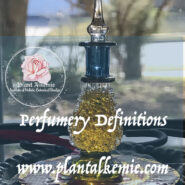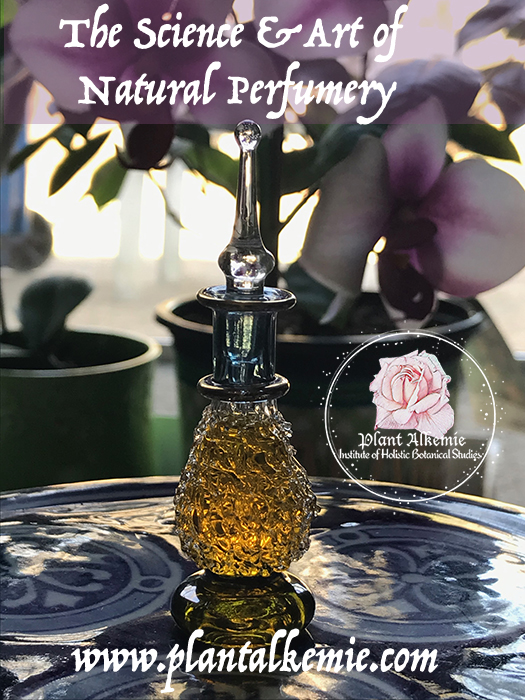Natural Perfumery Definitions: Accord, Dry Down, Development, Notes, and Tenacity

Natural perfume making is both an art and science. But before you start creating perfumes, it is best to learn a bit about them: the ‘science’ part. I have defined a few common perfume terms that people may confuse with each other. Different people may define terms a bit differently, but these are my personal definitions of these common perfume terms.
When I make natural perfumes, I work mostly with aromatics, such as essential oils, CO2 extracts, absolutes, and oleoresins. I use herb infused oils and tinctures too. Although I am using many of the same ingredients that I use in aromatherapy and herbalism, making aromatherapy scent blends and herbal preparations are different than making natural perfumes. There is some overlap between these fields, but there are many differences in techniques and methods too. This is why I decided to explain some of the key terminology used in perfumery.
Accord: This term is similar to a chord in music: a few notes are combined together to create a chord. The same is true in perfumery: an accord is when a couple or a few aromatics are combined together, and the blend of aromatics creates a new synergistic, unique aroma. Examples are a top note accord, floral accord, woody accord, citrus accord, gourmand accord, or chypre accord.
Base Note: Base notes last the longest on the skin. They are often used as fixatives to help anchor and make the top and middle notes stay longer on the skin. They can last several to many hours on the skin. Examples are patchouli (Pogostemon cablin) essential oil, absolute, or CO2 extract. Or woody aromatics, such as West Australian sandalwood (Santalum spicatum) essential oil or CO2 extract.

Pictured above is a lovely glass perfume bottle from my friend aromatherapist Raghda Abdel Maksou of Ebers Consulting. I have filled this beautiful gift with one of my rose perfumes.
Dry Down: A lot of people mistakenly think that the dry down is how a fragrance changes over time from the very beginning to the end of a scent. However, dry down only refers to the final stage of the scent (after the top and middle notes have evaporated) when the scent has reached the base notes. During the dry down, the tenacity and the base notes are assessed.
Development: Development is how a scent changes over time. This is the actual process from the beginning to the end of an aroma or perfume.
Middle Note: This is the heart of the perfume, also called the heart note. The middle notes are the center or main ‘star’ of the perfume. Middle notes last longer than the top notes; usually they last a couple to several hours on the skin. Examples: many florals are middle notes, such as neroli (Citrus aurantium) essential oil or the ylang ylang (Cananga odorata) aromatics (essential oils, absolute, and CO2 extract).
Notes: This refers to a part of the perfume or a distinctive aroma. Most people have heard of top, middle, and base notes, which are parts of the perfume. But in perfumery, notes can also refer to a specific odor. For example: a fruity note, an herbaceous note, or a rose note.
Tenacity: This term refers to how long an aroma or note lasts over time.
Top Note: These are the notes you perceive first in a perfume. They are the most volatile notes, meaning they only stay minutes to maybe an hour or so on the skin. Examples: sweet orange (Citrus sinensis) essential oil or balsam fir (Abies balsamea) essential oil.
Resources:
Learn the difference between an herb infused oil and an infusion, and other herbal terms in my herbal definitions article!
I enjoy using herb infused oils in perfumery! Here are my recipes for herb infused oils, such as vanilla infused oil and also lilac infused oil.
I use tinctures, such as lilac tincture, in perfumery too!
Learn which aromatics blend well with patchouli, bergamot, carrot seed, clove, helichrysum, and lavender essential oils in my aromatherapy and natural perfumery blending notes article!
If you have any questions about these perfumery terms, please ask them in the comments of this article! For more information or if you have questions about natural perfumery, aromatherapy, herbalism, formulating, and eco living, please join Plant Alkemie Institute of Holistic Botanical Studies’ Facebook group and also Plant Alkemie Institute of Holistic Botanical Studies Facebook business page. And check out more articles here on Plant Alkemie Institute of Holistic Botanical Studies’ website: https://www.plantalkemie.com.

Great article and very informative.
Thank you, Raghda! And thanks again for the lovely gift of the perfume bottle. Have an amazing day; hugs! 🙂
Wonderful clarification. Really enjoyed the article Li.
Thank you, Rehne! Hugs! Have a great day!
Terrific and very helpful information! Thank you for writing this, Li.
Thank you, Kat! Have a lovely day! 🙂
Excellent article I totally enjoyed reading it
Thanks Robin! I am glad you enjoyed it! Take care! 🙂